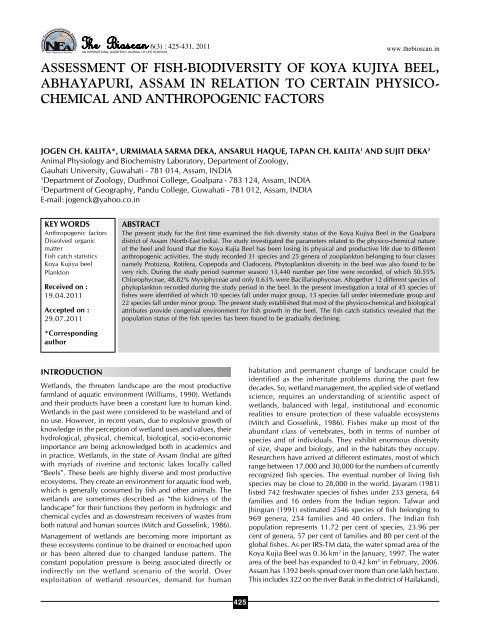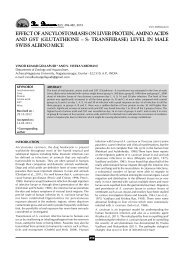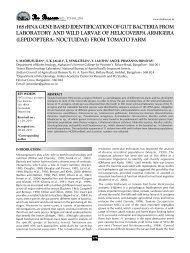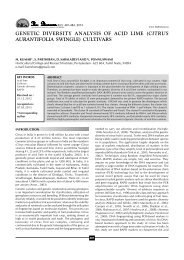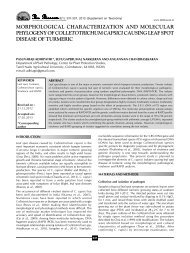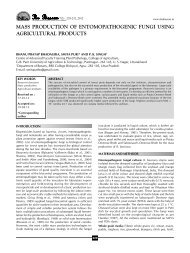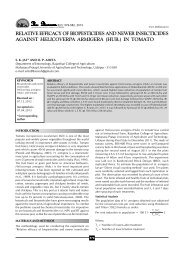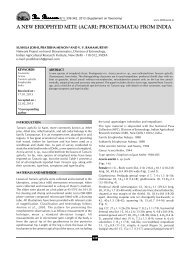NSave Nature to Survive - THE BIOSCAN
NSave Nature to Survive - THE BIOSCAN
NSave Nature to Survive - THE BIOSCAN
Create successful ePaper yourself
Turn your PDF publications into a flip-book with our unique Google optimized e-Paper software.
<strong>NSave</strong> <strong>Nature</strong> <strong>to</strong> <strong>Survive</strong><br />
6(3) : 425-431, 2011 www.thebioscan.in<br />
ASSESSMENT OF FISH-BIODIVERSITY OF KOYA KUJIYA BEEL,<br />
ABHAYAPURI, ASSAM IN RELATION TO CERTAIN PHYSICO-<br />
CHEMICAL AND ANTHROPOGENIC FACTORS<br />
JOGEN CH. KALITA*, URMIMALA SARMA DEKA, ANSARUL HAQUE, TAPAN CH. KALITA 1 AND SUJIT DEKA 2<br />
Animal Physiology and Biochemistry Labora<strong>to</strong>ry, Department of Zoology,<br />
Gauhati University, Guwahati - 781 014, Assam, INDIA<br />
1 Department of Zoology, Dudhnoi College, Goalpara - 783 124, Assam, INDIA<br />
2 Department of Geography, Pandu College, Guwahati - 781 012, Assam, INDIA<br />
E-mail: jogenck@yahoo.co.in<br />
KEY WORDS<br />
Anthropogenic fac<strong>to</strong>rs<br />
Dissolved organic<br />
matter<br />
Fish catch statistics<br />
Koya Kujiya beel<br />
Plank<strong>to</strong>n<br />
Received on :<br />
19.04.2011<br />
Accepted on :<br />
29.07.2011<br />
*Corresponding<br />
author<br />
INTRODUCTION<br />
ABSTRACT<br />
The present study for the first time examined the fish diversity status of the Koya Kujiya Beel in the Goalpara<br />
district of Assam (North-East India). The study investigated the parameters related <strong>to</strong> the physico-chemical nature<br />
of the beel and found that the Koya Kujia Beel has been losing its physical and productive life due <strong>to</strong> different<br />
anthropogenic activities. The study recorded 31 species and 25 genera of zooplank<strong>to</strong>n belonging <strong>to</strong> four classes<br />
namely Pro<strong>to</strong>zoa, Rotifera, Copepoda and Cladocera. Phy<strong>to</strong>plank<strong>to</strong>n diversity in the beel was also found <strong>to</strong> be<br />
very rich. During the study period (summer season) 13,440 number per litre were recorded, of which 50.55%<br />
Chlorophyceae, 48.82% Myxiphyceae and only 0.63% were Bacillariophyceae. Al<strong>to</strong>gether 12 different species of<br />
phy<strong>to</strong>plank<strong>to</strong>n recorded during the study period in the beel. In the present investigation a <strong>to</strong>tal of 45 species of<br />
fishes were identified of which 10 species fall under major group, 13 species fall under intermediate group and<br />
22 species fall under minor group. The present study established that most of the physico-chemical and biological<br />
attributes provide congenial environment for fish growth in the beel. The fish catch statistics revealed that the<br />
population status of the fish species has been found <strong>to</strong> be gradually declining.<br />
Wetlands, the threaten landscape are the most productive<br />
farmland of aquatic environment (Williams, 1990). Wetlands<br />
and their products have been a constant lure <strong>to</strong> human kind.<br />
Wetlands in the past were considered <strong>to</strong> be wasteland and of<br />
no use. However, in recent years, due <strong>to</strong> explosive growth of<br />
knowledge in the perception of wetland uses and values, their<br />
hydrological, physical, chemical, biological, socio-economic<br />
importance are being acknowledged both in academics and<br />
in practice. Wetlands, in the state of Assam (India) are gifted<br />
with myriads of riverine and tec<strong>to</strong>nic lakes locally called<br />
“Beels”. These beels are highly diverse and most productive<br />
ecosystems. They create an environment for aquatic food web,<br />
which is generally consumed by fish and other animals. The<br />
wetlands are sometimes described as “the kidneys of the<br />
landscape” for their functions they perform in hydrologic and<br />
chemical cycles and as downstream receivers of wastes from<br />
both natural and human sources (Mitch and Gosselink, 1986).<br />
Management of wetlands are becoming more important as<br />
these ecosystems continue <strong>to</strong> be drained or encroached upon<br />
or has been altered due <strong>to</strong> changed landuse pattern. The<br />
constant population pressure is being associated directly or<br />
indirectly on the wetland scenario of the world. Over<br />
exploitation of wetland resources, demand for human<br />
425<br />
habitation and permanent change of landscape could be<br />
identified as the inheritate problems during the past few<br />
decades. So, wetland management, the applied side of wetland<br />
science, requires an understanding of scientific aspect of<br />
wetlands, balanced with legal, institutional and economic<br />
realities <strong>to</strong> ensure protection of these valuable ecosystems<br />
(Mitch and Gosselink, 1986). Fishes make up most of the<br />
abundant class of vertebrates, both in terms of number of<br />
species and of individuals. They exhibit enormous diversity<br />
of size, shape and biology, and in the habitats they occupy.<br />
Researchers have arrived at different estimates, most of which<br />
range between 17,000 and 30,000 for the numbers of currently<br />
recognized fish species. The eventual number of living fish<br />
species may be close <strong>to</strong> 28,000 in the world. Jayaram (1981)<br />
listed 742 freshwater species of fishes under 233 genera, 64<br />
families and 16 orders from the Indian region. Talwar and<br />
Jhingran (1991) estimated 2546 species of fish belonging <strong>to</strong><br />
969 genera, 254 families and 40 orders. The Indian fish<br />
population represents 11.72 per cent of species, 23.96 per<br />
cent of genera, 57 per cent of families and 80 per cent of the<br />
global fishes. As per IRS-TM data, the water spread area of the<br />
Koya Kujia Beel was 0.36 km 2 in the January, 1997. The water<br />
area of the beel has expanded <strong>to</strong> 0.42 km 2 in February, 2006.<br />
Assam has 1392 beels spread over more than one lakh hectare.<br />
This includes 322 on the river Barak in the district of Hailakandi,
JOGEN CH. KALITA et al.,<br />
Karimganj and Cachar with water spread area of 8000 hectare.<br />
Total area of the beels associated with the river Brahmaputra<br />
and its tributaries in Assam is estimated at 92,000 hectare.<br />
Out of the existing beels, large beels in the range of 200 hectare<br />
and above numbering 16 cover an area of about 4600 hectare<br />
approximately. Nevertheless, contrary <strong>to</strong> average annual fish<br />
production of 6-7 kg per hectare from Indian reservoirs, the<br />
overall fish production from the beels of Assam is more than<br />
100 kg per hectare per year (Dey, 1981).<br />
MATERIALS AND METHODS<br />
Chemicals<br />
All the chemicals and the glasswares used in the present were<br />
purchased from the Nort East Chemicals Ltd, Guwahati,<br />
Assam.<br />
The study area<br />
Koya Kujiya Beel is situated in Abhayapuri <strong>to</strong>wn under the<br />
Tapattary Development Block of the Bongaigaon District of<br />
Assam (North-East India) at 26°17´45´NL and 90°39´EL.<br />
The beel is bounded by Batabari revenue village in the north<br />
and Lalmati village in the south. The eastern boundary is<br />
covered by Duramari/Mowamari, Naldoba and Kolbari<br />
revenue village. To the west the beel is bordered by National<br />
Highway-37and the Singimari hillock. The beel is of oblong<br />
shape and occupies a <strong>to</strong>tal area of 0.42 km2 . The Koya Kujia<br />
Beel is located at a distance of 25 km from the district head<br />
quarter, Bongaigaon and 3.5 km from North Salmara, the subdivisional<br />
head quarter. The Koya kujiya is the group of four<br />
small beels namely Koya, Folimary, Choutara and Muhuritana<br />
beel. The Koya Kujiya Beel is connected with the Kujiya River<br />
which finally flows down <strong>to</strong> the river Brahmaputra through its<br />
tributary, Manas. Presently, embankment is constructed on<br />
the outlet of this beel <strong>to</strong> check inflow of flood water and also <strong>to</strong><br />
resist the outflow of seedlings from the beel.<br />
Experimental procedures<br />
All the labora<strong>to</strong>ry experiments were carried out in the<br />
Department of Zoology, Gauhati University. The physicochemical<br />
parameters of water of the beel were derived adopting<br />
standard methods.<br />
Collection of Samples<br />
Water samples for the assessment of water quality were<br />
collected from the different pre selected points of the beel.<br />
Samples were collected in cleaned polythene containers and<br />
then tightly closed <strong>to</strong> avoid air contact or <strong>to</strong> prevent agitation<br />
during transport.<br />
Temperature<br />
Water temperature of the Koya Kujia Beel was measured with<br />
the help of mercury glass thermometer graduated from 0°C <strong>to</strong><br />
100°C X 1/10°C. The temperature was taken at the morning<br />
and evening hours at the depth of 10-15 cm. The range of<br />
fluctuation and the calculated average water temperature was<br />
recorded.<br />
Water transparency<br />
The water transparency in microhabitat terri<strong>to</strong>ries was studied<br />
using Secchi Disc of 20 cm diameter. The transparency of<br />
426<br />
water has been studied through visual observation by<br />
immersing the disc in water until it just disappeared and<br />
reappeared and calculated the mean value by following the<br />
standard method of APHA, (1995) and Garg et al. (2002). The<br />
unit of transparency was expressed in cm.<br />
Hydrogen ion concentration (pH)<br />
The pH level of the water in microhabitat terri<strong>to</strong>ries in the<br />
studied beel was recorded fortnightly and calculated the<br />
monthly average value from the pulled data for exposed<br />
terri<strong>to</strong>ries and within the burrows separately. The experiments<br />
were done with the help of digital pH meter (ELICO-120) with<br />
CM-63 combined electrodes.<br />
Dissolved oxygen<br />
Dissolved oxygen (DO) in mg L-1 was estimated by following<br />
the Alsterberz Azide modification of Winkler method.<br />
Free carbondioxide<br />
Free carbondioxide (FCO 2 ) was determined titrimetrically with<br />
N/44 NaOH solutions after using phenolphthalein as indica<strong>to</strong>r.<br />
Free CO 2 reacts with sodium hydroxide <strong>to</strong> form sodium<br />
bicarbonate, when titrated with N/44 sodium hydroxide near<br />
<strong>to</strong> the pH 8.3, it developed pink colour. The burette reading of<br />
titrant was recorded and FCO 2 calculated by the following<br />
formula:<br />
FCO 2 mg L -1 =<br />
Where, V = volume of water sample taken (100 mL)<br />
1<br />
V = volume (ml) of titrant required (N/44 NaOH)<br />
2<br />
Total Alkalinity<br />
Total alkalinity (TA) was estimated titrimatrically with 0.02<br />
NH 2 SO 4 using phenolphthalein (pH=8.4) and methyl orange<br />
indica<strong>to</strong>r. The titrate value of phenolphthalein alkalinity was<br />
added <strong>to</strong> the titrate value obtained in methyl orange end <strong>to</strong> get<br />
the <strong>to</strong>tal alkalinity of the sample. The calculation was done by<br />
following the standard method of APHA (1995).<br />
Total Hardness<br />
Total hardness (TH) within the microhabitat terri<strong>to</strong>ries in the<br />
studied beel was estimated by titrimetric method<br />
(Chat<strong>to</strong>padhyay, 1998).<br />
Calcium and magnesium concentration<br />
Calcium concentration was estimated by titrimetric method<br />
using EDTA (0.01 N) as titrant and Murexide indica<strong>to</strong>r<br />
(commercial calcium hardness tablet) by following the method<br />
of APHA (1995) and Chat<strong>to</strong>padhyay (1998). The magnesium<br />
of water within the microhabitat terri<strong>to</strong>ries was determined as<br />
the differences between <strong>to</strong>tal hardness and calcium hardness<br />
multiplied by a fac<strong>to</strong>r 0.244 (Chat<strong>to</strong>padhyay, 1998; Garg et<br />
al., 2002).<br />
Dissolved organic matter (DOM)<br />
The DOM in the water of exposed terri<strong>to</strong>ries and inside the<br />
burrows of microhabitat was estimated following the method<br />
used by Chat<strong>to</strong>padhaya (1998).<br />
RESULTS AND DISCUSSION<br />
Physico-chemical features of water<br />
V x 10 2<br />
V1
The results of some of the physico-chemical features of the<br />
water samples of Koya Kujiya Beel, viz., temperature,<br />
transparency, pH, dissolved oxygen, free carbon dioxide, <strong>to</strong>tal<br />
alkalinity, <strong>to</strong>tal hardness, dissolved organic matter, calcium<br />
and magnesium concentration which were estimated during<br />
the study period and presented in Table 1.<br />
Water temperature<br />
The monthly average value of water temperature of Koya<br />
Kujiya Beel has been recorded as 18°C during January and<br />
33°C in the month of August, with an annual mean value of<br />
26.5°C during the study period (Table 1). This range of<br />
temperature is generally suitable for fish culture and their<br />
growth and development.<br />
Hydrogen ion concentration (pH)<br />
Water pH is the indica<strong>to</strong>r of acidity and alkalinity of water<br />
body. The monthly average concentration of pH was recorded<br />
from 6.0 <strong>to</strong> 8.9 with a mean value of 6.8 during the study<br />
period.<br />
Water transparency<br />
Water transparency of Koya Kujiya Beel was recorded with a<br />
very less fluctuation. The present investigation indicated that<br />
the water transparency ranges from 42.0 cm <strong>to</strong> 95.0 cm with<br />
a mean value of 56.0 cm. Minimum values recorded during<br />
the month of July-August and maximum value recorded during<br />
the month of Oc<strong>to</strong>ber-January (Table 1). Such narrow range<br />
of water transparency fluctuation indicates the narrow range<br />
Table 2: Zooplank<strong>to</strong>n density and diversity identified in Koya Kujiya Beel<br />
427<br />
Table 1: Physico-chemical conditions of water in Koya Kujiya Beel<br />
Parameters Mean value (Range) Remarks<br />
Water temp (ºC) 26.5 (18.0 - 33.0) Productive<br />
pH 6.8 (6.0 - 8.9) Productive<br />
Water transparency (cm) 56.0 (42.0 - 95.0) Productive<br />
Dissolved oxygen (mg L -1 ) 5.4 (4.2 - 9.0) Productive<br />
Free carbon dioxide (mg L -1 ) 3.2 (1.0 - 9.4) Productive<br />
Total alkalinity (mg L -1 ) 37.6 (34.0 - 95.0) Productive<br />
Total hardness (mg L -1 ) 35.0 (25.0 - 140.0) Productive<br />
Dissolved organic 3.45 (2.26 - 5.68) Productive<br />
matter (mg L -1 )<br />
Calcium (mg L -1 ) 15.0 (9.0 - 26.0) Productive<br />
Magnesium (mg L -1 ) 12.0 (7.0 - 18.0) Productive<br />
of fluctuation in physical condition of water like siltation,<br />
pollution entrance of other organic substances in the studied<br />
beel.<br />
Dissolved oxygen<br />
The dissolved oxygen content of the water of the beel varied<br />
widely during the study period. Variations of dissolved oxygen<br />
content were recorded from 4.2 mg L -1 <strong>to</strong> 9.0 mg L -1 with a<br />
mean value of 5.7 mg L -1 (Table 1). Thus the present study<br />
reveals that the dissolved oxygen concentration of the beel is<br />
very much suitable for aquaculture.<br />
Free carbon dioxide<br />
FISH-BIODIVERSITY OF KOYA KUJIYA BEEL<br />
The free carbon dioxide content in water of the studied wetland<br />
was recorded from 1.0 mg L -1 <strong>to</strong> 9.4 mg L -1 with a mean value<br />
of 3.2 mg L -1 during the study period (Table 1). This fluctuation<br />
Group of Zooplank<strong>to</strong>n Species Density (Number/litre) Remarks<br />
1. Pro<strong>to</strong>zoa Euglena spirogyra 14 Total number 56 (22.9% of<br />
Chilomonas paramecium 2 the <strong>to</strong>tal zooplank<strong>to</strong>n/litre)<br />
Euglena acus 8<br />
Phacus longicauda 7<br />
Phacus pleuronectes 11<br />
Chlamydomonas anqulosa 3<br />
Vorticella sp. 8<br />
Holophyra simplex 3<br />
2. Rotifera Brachionus sp. 12 Total number 49 ( 20.8% of the<br />
Brachionus forficula 8 <strong>to</strong>tal zooplank<strong>to</strong>n / litre)<br />
Keratella tropica 9<br />
Lecane sp. 13<br />
Asplanchna intermedia 5<br />
3. Crustacea<br />
Rotaria rota<strong>to</strong>ria 2<br />
(a) Cladocera Artemia salina 10 Total number 60 (24.6% of<br />
Daphnia pulex 9 the <strong>to</strong>tal zooplank<strong>to</strong>n / litre)<br />
Daphnia magna 10<br />
Moina brachiata 3<br />
Moina flagellate 4<br />
Macrothrix sp. 5<br />
Alona sp. 8<br />
Cydorus sp. 9<br />
(b) Copepoda Phylodiap<strong>to</strong>mus sp. 11 Total number 77 (31.6% of the <strong>to</strong>tal<br />
Paradiap<strong>to</strong>mus sp. 12 zooplank<strong>to</strong>n / litre)<br />
Neodiap<strong>to</strong>mus sp. 8<br />
Megadiap<strong>to</strong>mus sp. 10<br />
Eucyclops agilis 14<br />
Macrocyclops sp. 9<br />
Mesocyclopes leuckarti 7<br />
Tropodiap<strong>to</strong>mus sp. 6<br />
Total 244
JOGEN CH. KALITA et al.,<br />
Table 3: Density and diversity of phy<strong>to</strong>plank<strong>to</strong>n in Koya Kujiya,<br />
Abhayapuri, Assam<br />
Types and species Density per liter Remarks<br />
Myxophyceae Total number 6561<br />
Nos<strong>to</strong>c linckia 3043 (48.82% of the <strong>to</strong>tal<br />
phy<strong>to</strong>plank<strong>to</strong>n / litre)<br />
Anabaena sp. 938<br />
Microcystis sp. 2580<br />
Chlorophyceae Total number 6794<br />
Volvox aureus 4052 (50.55% of the <strong>to</strong>tal<br />
phy<strong>to</strong>plank<strong>to</strong>n / litre)<br />
Eudorina elegans 1485<br />
Spirogyra spiralis 7<br />
Ulothrix zonata 1150 Total number 85<br />
Bacillariophyceae (0.63% of the <strong>to</strong>tal<br />
phy<strong>to</strong>plank<strong>to</strong>n / litre)<br />
Tabellaria fenestrata 23<br />
Pinnularia sp. 8<br />
Dia<strong>to</strong>ma sp. 17<br />
Asterionella formusa 6<br />
Melosera 31<br />
Total 13,440<br />
of FCO 2 was resulted by the presence of varieties of aquatic<br />
weeds, which were responsible for increase of FCO 2 beel<br />
concentration during early morning and night, while depletion<br />
resulted during day time.<br />
Total alkalinity<br />
Total alkalinity plays an important role in fresh water ecology.<br />
The average value of <strong>to</strong>tal alkalinity of the beel water was<br />
recorded 37.6 mg L -1 . However, the range of TA in the studied<br />
beel was recorded from 34.0 mg L -1 <strong>to</strong> 95.0 mg L -1 (Table 1).<br />
Total hardness<br />
Total hardness is the indica<strong>to</strong>r of <strong>to</strong>tal calcium and magnesium<br />
salts present in water. It plays a significant role in the<br />
productivity of fresh water habitat. The <strong>to</strong>tal hardness in water<br />
of the studied beel was recorded from 25.0 mg L -1 <strong>to</strong>140 mg L -<br />
1 with a mean value of 35.0 mg L -1 (Table 1).<br />
Calcium and magnesium concentration<br />
The calcium and magnesium content in freshwater is also an<br />
important fac<strong>to</strong>r for maintaining productivity of water.<br />
Dissolved calcium concentrations in water of the studied beel<br />
was recorded from 9.0 mg L -1 <strong>to</strong> 26.0 mg L -1 with a mean value<br />
of 15.0 mg L -1 . The present findings indicate that the water of<br />
the beel contains available calcium, which maintain the<br />
alkalinity of the water body. Similarly, the average value of<br />
magnesium concentration was 12.0 mg L -1 with a range<br />
recorded from 7.0 mg L -1 <strong>to</strong> 18.0 mg L -1 (Table 1).<br />
Dissolved organic matter<br />
The dissolved organic matter of water indicates some <strong>to</strong>tal of<br />
the organic substances dissolve in it in the form of different<br />
soluble substances. The dissolved organic matter in water of<br />
Koya Kujiya Beel was recorded from minimum of 2.26 mg L -1<br />
<strong>to</strong> maximum of 5.68 mg L -1 with a mean value of 3.45 mg L -1<br />
(Table 1). The fluctuation of DOM in the studied beel exhibits<br />
a very good productive condition of the water body and<br />
suitable for aquaculture. High concentration of dissolved<br />
organic matter implies presence of high nutritive organic matter<br />
for fishes, which supports fast growth of several fish species.<br />
428<br />
Plank<strong>to</strong>n diversity in the beel<br />
Zooplank<strong>to</strong>n<br />
The diversity and density (number L -1 ) of zooplank<strong>to</strong>n were<br />
recorded during the period from May, 2007 <strong>to</strong> August, 2007<br />
in different location and depth of the studied beel. Four major<br />
groups of zooplank<strong>to</strong>n have been recorded in the beel, which<br />
exhibited average density of 244 numbers L -1 (Table 2). Thirty<br />
one species and twenty five (25) genera of zooplank<strong>to</strong>n<br />
belonging <strong>to</strong> four classes namely Pro<strong>to</strong>zoa, Rotifera, Copepoda<br />
and Cladocera were identified with varying densities. The<br />
order of average density of zooplank<strong>to</strong>n in the beel were<br />
recorded as Copepods (31.6 %) > Cladocera (24.7 %) ><br />
Pro<strong>to</strong>zoa (22.9 %) > Rotifera (20.8 %) (Table 2).<br />
Among the eight different species of Pro<strong>to</strong>zoan, Euglena and<br />
Phacus were recorded as dominant, while the Chilomonus<br />
and Chlamidomonas showed very low density. Among the<br />
Rotifers, Brachionus and Lecane sp. were recorded as<br />
dominant and Rotaria and Asplanchna sp. were in low density<br />
in the beel. Similarly, Daphnia and Artemia sp. belonging <strong>to</strong><br />
Cladocera and Eucyclopes and Phylodiap<strong>to</strong>mus belonging<br />
<strong>to</strong> Copepodes were found as dominant zooplank<strong>to</strong>n in the<br />
studied beel. On the other hand, the genus Macrothrix, Moina<br />
and Alona of Cadocera and the genus Tropodiap<strong>to</strong>mus and<br />
Neodiap<strong>to</strong>mus belonging <strong>to</strong> Copepodes were recorded with<br />
low density in the beel during the study period.<br />
Phy<strong>to</strong>plank<strong>to</strong>n<br />
Phy<strong>to</strong>plank<strong>to</strong>n diversity in the beel was also very rich. During<br />
the study period (summer season) there were 13,440 number<br />
per litre phy<strong>to</strong>plank<strong>to</strong>n was recorded, of which 50.55%<br />
Chlorophyceae, 48.82% Myxiphyceae and only 0.63%<br />
Bacillariophyceae. Al<strong>to</strong>gether 12 different species of<br />
phy<strong>to</strong>plank<strong>to</strong>n were recorded during the study period in the<br />
beel (Table 3). Chlorophyceae and Myxophyceae was the<br />
major constituent of phy<strong>to</strong>plank<strong>to</strong>n which indicated suitability<br />
of the water body of the beel for aquaculture.<br />
Fish resources of Koya Kujiya Beel<br />
Fish diversity of Koya Kujiya Beel has been recorded after the<br />
physical verification and interview with the local fishermen of<br />
the beel. Fish specimens are collected from the fishermen and<br />
the lessee of the beel and were identified on spot and in<br />
labora<strong>to</strong>ry by following standard methodologies (Talwar and<br />
Jhingran, 1991; Vishwanath, 2002). There were 45 species of<br />
fishes recorded in the beel during the study period. All <strong>to</strong>gether<br />
45 fish species were known <strong>to</strong> occur in the beel and their<br />
status was determined after field study and interviewing the<br />
fishermen and the lessee of the studied beel area. The Table 4<br />
shows the fish resources of the beel. Among the species<br />
identified in the present study, 10 species under major group,<br />
13 species under intermediate group and 22 species were<br />
under minor group on the basis of their size at matured stage.<br />
Major group<br />
There were 10 fish species recorded in the beel during the<br />
study period which were included as major group (Table 4).<br />
Among these fishes Catla catla, Labeo rohita, Labeo gonius,<br />
Cirrhinus mrigala were found as major constituent, but their<br />
quantities were in decreasing in order. The fish species like<br />
Labeo calbasu, Channa striatus, Aorichthys seenghala had
Table 4: Fish resources reported from Koya Kujiya Abhayapuri, Assam<br />
Fish group<br />
Major Group<br />
Availability in the beel Population Status Utility<br />
Catla catla Available Decreased FF<br />
Labeo rohita Available Decreased FF<br />
Labeo calbasu Medium Decreased FF<br />
Labeo gonius Available Same FF<br />
Cirrhinus mrigala Available Same FF<br />
Aorichthys seenghala Medium Decreased FF<br />
Aorichthys aor Low Decreased FF<br />
Wallago attu Low Decreased Ff<br />
Channa striatus Medium Decreased FF<br />
Channa marulius<br />
Intermediate group<br />
Low Decreased FF<br />
Labeo bata Available Decreased FF<br />
Cirrhinus reba Medium Decreased FF<br />
Eutropichthys vacha Available Same FF<br />
Clupisoma garua Medium Decreased FF, OF<br />
Ompok bimaculatus Low Decreased FF, OF<br />
Heteropneustes fossilis Available Same FF<br />
Clarias batrachus Available Same FF<br />
Channa punctatus Medium Same FF, OF<br />
Channa gasua Available Decreased FF, OF<br />
Mastacembelus armatus Available Decreased FF, OF<br />
Macrognathus aculeatus Low Decreased FF, OF<br />
No<strong>to</strong>pterus no<strong>to</strong>pterus Medium Decreased FF, OF<br />
Anabas testudineus<br />
Minor group<br />
Medium Decreased FF<br />
Puntius sophore Low Decreased FF, OF<br />
P. phu<strong>to</strong>nio Available Same FF, OF<br />
P. tic<strong>to</strong> Available Decreased FF, OF<br />
P. gelius Low Decreased FF, OF<br />
Mystus tengra Low Decreased FF, OF<br />
M. vitatus Medium Decreased FF<br />
M. cavasius Medium Decreased FF<br />
M. bleekeri Medium Same FF<br />
Clupisoma atherionoides Available Same FF, OF<br />
Gadusia chapra Medium Same FF, OF<br />
Danio davario Low Decreased FF, OF<br />
Rasbora rasbora Available Decreased FF, OF<br />
R. daniconius Medium Same FF, OF<br />
R. elanga Available Decreased FF, OF<br />
Salmos<strong>to</strong>ma bacaila Available Same FF, OF<br />
Amblypharyngodon mola Medium Same FF, OF<br />
Batasio batasio Low Decreased FF, OF<br />
Chanda nama Medium Decreased FF, OF<br />
Chanda ranga Medium Same FF, OF<br />
Badis badis Low Decreased FF, OF<br />
Tetradon cutcutea Low Same OF<br />
Chacca chacca Medium Decreased OF<br />
Table 5: Fish catch composition of Koya Kujiya Beel, Abhayapuri,<br />
Assam during the year 2000 and 2006<br />
S. No. Fish group Year 2000 Year 2006<br />
1 Total catch 55 MT. 38 MT.<br />
2 Major group 54% 26%<br />
3 Intermediate group 21% 18%<br />
4 Minor group 25% 66%<br />
been recorded in medium quantities. Similarly other species<br />
like Aorichthys aor, Wallago attu, Channa marulius had been<br />
recorded with low quantities and decreasing population.<br />
Intermediate group<br />
In intermediate fish group13 species of fishes were recorded<br />
(Table 4). This group of fish includes the species like Labeo<br />
429<br />
FISH-BIODIVERSITY OF KOYA KUJIYA BEEL<br />
bata, Cirrhinus reba, Eutropichthys vacha, Clupisoma garua,<br />
Ompok bimaculatus, Heteropneustes fossilis, Clarias<br />
batrachus, Channa punctatus, Channa gasua, Mastacembelus<br />
armatus, Macrognathus aculeatus, and No<strong>to</strong>pterus<br />
no<strong>to</strong>pterus. However, among these fish species most of them<br />
are found in decreasing order in population. Amongst the<br />
fishes of intermediate group recorded in the present study, 9<br />
species have ornamental value.<br />
Minor group<br />
This group includes all trash fishes. The study recorded 22<br />
fish species from the beel belong <strong>to</strong> minor group of which 13<br />
species were found in decreasing order (Table 4). The fish<br />
species like Puntius sophore, Salmos<strong>to</strong>ma bacaila, Puntius
JOGEN CH. KALITA et al.,<br />
gelius, Mystus cavasius, Mystus bleekeri, Tetradon cutcutea<br />
and Chacca chacca were occurred in very low quantities and<br />
their population status was also found <strong>to</strong> be in decreasing<br />
order (Table 4). Among the fishes of minor group about 19<br />
species were of ornamental value. Unfortunately, these fishes<br />
having high ornamental value were found <strong>to</strong> be brought <strong>to</strong><br />
the market as ordinary food fish with a minimum market price.<br />
Fish catch statistics<br />
The fish catch statistics during the study period clearly<br />
indicated that the fishes belonging <strong>to</strong> the major group were<br />
gradually decreasing from 54% in the year 2000 <strong>to</strong> 26%<br />
recorded in the year 2006 (Table 5). Similarly the fishes<br />
belonging <strong>to</strong> intermediate group decreased from 21% in 2000<br />
<strong>to</strong> 18% in 2006. However, the fishes of minor group comprised<br />
of 25% of the <strong>to</strong>tal catch during the year 2000 while during<br />
the year 2006 it was recorded as 66% of the <strong>to</strong>tal catch. The<br />
statistical analysis clearly indicated that the fishes belonging<br />
<strong>to</strong> the major and intermediate groups were in decreasing order.<br />
On the other hand, the <strong>to</strong>tal catch of fish during the year 2000<br />
was recorded as 55 metric <strong>to</strong>n (MT) and this value decreased<br />
<strong>to</strong> 38 MT during the year 2006 (Table 5).<br />
The Natural wetlands provide the habitat for diversified air<br />
breathing as well as other indigenous ichthyo-species. Several<br />
workers notably Welch (1952), Hora and Pillay (1962),<br />
Dehadrai and Tripathi (1976) have studied the characteristics<br />
of swamps, marshes and wetlands from different environment,<br />
which were identified as the natural habitat of different fish<br />
species. Similarly, the present investigation was conducted in<br />
Koya Kujia Beel of Bongaigaon district of Assam and the<br />
physico-chemical conditions of water along with the plank<strong>to</strong>n<br />
composition and the ichthyo-faunal diversity in the beel was<br />
been critically analyzed. Temperature is one of the most<br />
significant parameter among the physical and chemical<br />
attributes of the water environment, which directly and<br />
indirectly influence on almost all the living processes of the<br />
aquatic organisms. Being the poikilothermic animal, fish has<br />
the ability <strong>to</strong> adapt and live at very different temperature<br />
gradients but it affects on the general metabolism of fishes.<br />
The present finding reveals that the water temperature of Koya<br />
Kujia Beel is in the suitable range for growth and development<br />
of fish.<br />
The water transparency is another important physical attribute,<br />
which acts as a productivity indica<strong>to</strong>r of the water body. It is<br />
directly related with the quantity of suspended particles and<br />
biotic community present in water (Jhingran, 1985). Banerjee<br />
(1967) has reported that the water transparency less than 30<br />
cm and more than 70 cm is generally less productive and<br />
affect the growth and productivity of fish. In the present findings<br />
the water transparency of the beel is found within highly<br />
productive range (42.0-95.0 cm). Similarly all the chemical<br />
parameters like dissolved oxygen, free carbon dioxide, <strong>to</strong>tal<br />
alkalinity, <strong>to</strong>tal hardness, calcium and magnesium<br />
concentration of the studied water body have been recorded<br />
within the suitable range for growth and development of fish<br />
and other aquatic organisms (Table 1). Hydrogen ion<br />
concentration (pH) is an indica<strong>to</strong>r of various attributes of water<br />
body. It has direct and indirect effects on the growth and<br />
development of aquatic organisms including fishes. The pH<br />
of any water body generally undergoes diurnal as well as<br />
430<br />
seasonal variation. However, the optimum pH level of water<br />
for fish culture ranges from 6.5 <strong>to</strong> 8.5 (Banerjee, 1967;<br />
Jhingran, 1985). In the present investigation the pH range of<br />
the beel water has been recorded from 6.0 <strong>to</strong> 8.9 (Table 1).<br />
This corroborates the findings of several workers in different<br />
wetlands of Assam (Dey, 1981; Lahon, 1983; Goswami, 1985;<br />
Agarwal, 1996).<br />
Dissolved organic matter concentration depends on the rate<br />
of decomposition of organic matters and the nature of soil.<br />
Higher value of DOM is the characteristic of swamp, which is<br />
due <strong>to</strong> decomposition of organic matters (Munshi and Hughes,<br />
1991). In the present investigation higher value of DOM<br />
concentration was found in the beel water (3.45 mg L-1 ) (Table<br />
1). This higher DOM was resulted due <strong>to</strong> prolonged stagnation<br />
of water and decomposition of detritus in the burrows. Higher<br />
DOM is an indica<strong>to</strong>r of nutrient rich water (Munshi and<br />
Hughes, 1991), which also gives support <strong>to</strong> nutrient flow in<strong>to</strong><br />
the burrows from the overlying swamps. This result of the<br />
present study coincides with the findings in different wetlands<br />
of Assam (Dey, 1981; Lahon, 1983; Goswami, 1985; Dey and<br />
Kar, 1987; Yadav, 1987; Agarwal, 1996; Thakuria and Sarma,<br />
2005; Kalita and Goswami, 2006). Plank<strong>to</strong>n is of immense<br />
value as food, indica<strong>to</strong>r of various physico-chemical and<br />
biological properties of natural water body. Several authors<br />
contributed their works on the importance of plank<strong>to</strong>n on the<br />
productivity of water body and role in aquaculture in different<br />
aspects (Pennak, 1953; Edmondson, 1959; Goswami, 1985).<br />
Present study reveals that the studied beel was rich with 31<br />
different species of zooplank<strong>to</strong>n (Table 2) and 12 species of<br />
phy<strong>to</strong>plank<strong>to</strong>n (Table 3), which exhibits a congenial<br />
environment for fish growth in the beel.<br />
In the present investigation it has been observed that most of<br />
the physico-chemical and biological attributes provide<br />
congenial environment of the beel for fish growth. However,<br />
the study of fish catch statistics reveals that the population<br />
status of different fish species was gradually declining (Table<br />
5). The local fishermen and the lessee of the beel also<br />
confirmed the same phenomena. Majorty of the Indian major<br />
carps and some commercially important fishes like Channa<br />
striatus, C. marulius, Aorichthys seenghala, Aorichthys aor,<br />
Wallago attu had been recorded as critically declining species<br />
in the beel. Moreover, a variety of ornamental fish species<br />
were recorded and found declining drastically (Table 4). The<br />
fish catch statistics of the beel also supported that the population<br />
status of most of the fishes are in declining trend. Moreover,<br />
the water area of the Koya Kujiya Beel expanded from 0.36<br />
km2 in January, 1997 <strong>to</strong> 0.42 km2 in February, 2006. This is<br />
because of the clearance of the unusual growth of vegetation<br />
of the beel under the National Rural Employment Guarantee<br />
Programme (NREGP) from August, 2006. On the other hand,<br />
the other waterbodies, which had occupied 0.40 km2 in 1997,<br />
has shrunk <strong>to</strong> 0.34 km2 in the year 2006. The shrinking of the<br />
beel caused by the deposits carried down from the adjoining<br />
areas, which indicates over exploitation and encroachment<br />
around the beel. It was found that the villagers were using<br />
chemical fertilizers in their agricultural field. During rainy<br />
season the run off water along with eroded materials carry<br />
some amount of dissolved chemical substances from its<br />
surrounding agricultural fields <strong>to</strong> its low lying areas. As such
there was a continuous addition of chemical substances and<br />
eroded materials in the present studied beel that effected the<br />
growth and development of fish by affecting the chemical<br />
content, pH, turbidity and temperature conditions of water of<br />
the beel. In our investigation the fish catch statistics also<br />
revealed that there was a decline in fish population of the beel<br />
(Table 5), which confirmed the impact of anthropogenic<br />
influences on fish bio-diversity of the studied Koya Kujiya<br />
Beel.<br />
REFERENCES<br />
APHA. 1995. Standard Methods for the Examination of Water and<br />
Waste Water, American Public Health Association, New York, USA.<br />
Agarwal, N. K. 1996. Limnology and fish productivity of Tamranga<br />
Wetland, Bongaigaon District of Assam (India) with special reference<br />
<strong>to</strong> some productivity indica<strong>to</strong>r. Ph.D. Thesis, Gauhati University, India.<br />
Banerjee, S. M. 1967. Water quality and soil conditions of fish ponds<br />
in some states of India in relation <strong>to</strong> fish production. Indian J. Fish.<br />
14: 115-144.<br />
Chat<strong>to</strong>padhyay, G. N. 1998. Chemical Analysis of Fish Pond Soil and<br />
Water. Daya Publishing House, Delhi.<br />
Dehadrai, P. V. and Tripathi, S. D. 1976. Environment and ecology<br />
of freshwater of air breathing teleosts. In: Respiration of Amphibious<br />
Vertebrates, Hughes, G. M. (Ed). Academic Press, London-New York,<br />
pp.39-72.<br />
Dey, S. C. 1981. Studies on the hydrobiological conditions of some<br />
commercially important lakes (Beels) of Kamrup district of Assam<br />
and their bearing on fish production. Final Technical Report. NEC.<br />
(Government of India), p.177.<br />
Dey, S. C. and Kar, D. 1987. Physicopchemical complexes of water<br />
and soil in Sone, and Ichthyological potential tec<strong>to</strong>nic lake of Assam.<br />
J. Assam Sci. Soc. 30: 1-11.<br />
Edmondson, W. T. 1959. Fresh Water Biology (2nd Ed). John Wiley &<br />
Son. Inc. New York, p.1248.<br />
Garg, S. K., Bhatnagar, A., Kalla, A. and Johal, M. S. 2002.<br />
Experimental Ichthyology. CBS Publishers and Distribu<strong>to</strong>rs, New<br />
Delhi, p.170.<br />
Goswami, M. M. 1985. Limnological investigations of a tec<strong>to</strong>nic lake<br />
431<br />
FISH-BIODIVERSITY OF KOYA KUJIYA BEEL<br />
of Assam, India and their bearing on fish production. Ph.D. Thesis,<br />
Gauhati University, India, p.395.<br />
Hora, S. L. and Pillay, T. V. R. 1962. Handbook on fish culture in the<br />
Indo-Pacific Region. Hoar, W.S., Randall, D. J. and Farrell, A. P.<br />
(Eds). Academic Press, INC., England.<br />
Jayaram, K. C. 1981. Studies on the age and growth of Cirrhinus<br />
mrigala (Ham) from the River Ganga. Proc. Nat. Inst. Sci. India. 25:<br />
107-137.<br />
Jhingran, A. G. 1985. Impact of environmental stress on fresh water<br />
fisheries Resources. J. Inland Fish. Soc. India. 23: 20-32.<br />
Kalita, T. C. and Goswami, M. M. 2006. Microhabitat of Monopterus<br />
cuchia (Hamil<strong>to</strong>n and Buchanan, 1822): A case study in wetlands of<br />
Goalpara district of Assam, India. Aquacult. 7: 43-52.<br />
Lahon, B. 1983. Limnology and Fisheries of some commercial beels<br />
of Assam (India). Ph.D. Thesis, Gauhati University, India. p.351.<br />
Mitch, W. J. and Gosselink, J. G. 1986. Wetland Vannostrand<br />
Reinhold, New Work. p.537.<br />
Munshi, J. S. D. and Hughes, G. M. 1991. Air-breathing Fishes of<br />
India: Their structures, Function and Life His<strong>to</strong>ry. Oxford and IBH<br />
Publishing Co. Pvt. Ltd. p.338.<br />
Pennak, R. W. 1953. Fresh water Invertebrates of the United States.<br />
Ronald Press Co. New York., p.769.<br />
Talwar, P. K. and Jhingran, A. G. 1991. Inland Fishes of India and<br />
Adjacent Countries. Vol 1. A.A. Balkema, Rotterdam. p.541.<br />
Thakuria, P. and Sarma, B. K. 2005. Ecology and biodiversity of<br />
zooplank<strong>to</strong>n in a flood plain lake of Brahmaputra Basin. In:<br />
Brahamaputra Beckons, (Souvenir, 2nd International Conference on<br />
Brahmaputra civilization, Abedin, D.J. (Ed), pp.95-104.<br />
Vishwanath, W. 2002. Fishes of North East India A field guide <strong>to</strong><br />
species identification. Agricultural Technology Project, Department<br />
of Life Sciences, Manipur University, India.<br />
Welch, P. S. 1952. Limnology (2nd Ed). Mc Graw Hill Book Co. New<br />
York.<br />
Williams, M. 1990. Wetlands: A Threatened Landscape. Basil<br />
Blackwell Ltd., Oxford, U.K. p.419.<br />
Yadav, Y. S. 1987. Studies on the limnology and productivity on an<br />
Ox-bow lake in Dhubri district of Assam (India). Ph.D. Thesis, Gauhati<br />
University, India.
432


